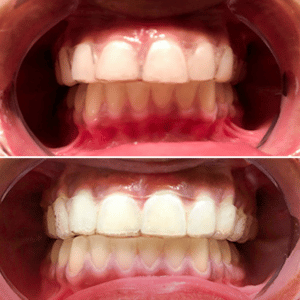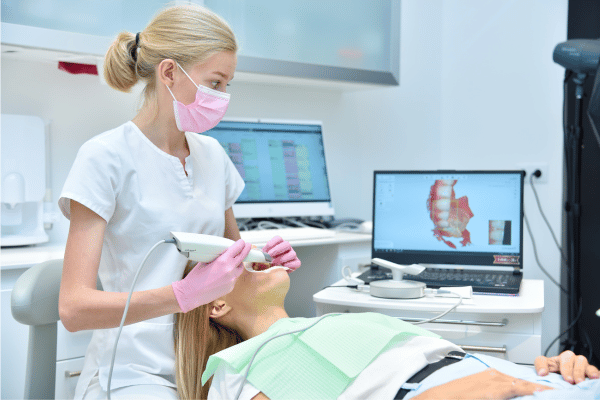
Table of Contents
Introduction
In this in-depth guide, know the distinction between overbite and overjet. Although they are frequently used, these phrases in dentistry can be misleading. To help you better understand your oral health, we'll define overjet and overbite, as well as discuss its causes, variations, and available treatments, in this blog. So let's get into it.
What is Overjet?

When the jaws are closed, there is a horizontal space between the top and lower front teeth, known as overjet. Simply put, it's the extension of the upper front teeth over the lower front teeth.
Causes of Overjet:
Several factors can contribute to the development of overjet:
- Genetics: As certain people may inherit jaw structures that contribute to the disorder, genetic predisposition can play a key influence in the genesis of overjet.
- Misalignment of the Jaws: Overjet may arise from an imbalance in the positioning of the upper and lower jaws. There are several possible causes of this misalignment, including trauma or developmental problems.
- Habits: Childhood habits like thumb-sucking and tongue-thrusting can lead to overjet, affecting teeth and jaw development.
Symptoms and Effects:
The following signs and symptoms may be present in people with overjet:
- Speech Issues: Protrusion of the top front teeth can cause problems with articulation and pronunciation by reducing the clarity of speech.
- Difficulty Biting or Chewing: An improper bite can make it difficult to properly bite or chew some meals, which might affect one's eating habits in general.
- Risk of Dental Injury Increased: The front teeth that protrude are more vulnerable to trauma and injury, particularly in the event of an accident or fall. Because of this increased risk, treating overjet is crucial to averting future dental crises.
What is Overbite?

When the jaws are closed, the higher front teeth overlap the lower front teeth vertically, a dental disorder known as overbite. Simplified, it describes the vertical coverage of the lower front teeth by the upper front teeth.
Causes of Overbite:
Like overjet, an overbite can result from several things.
- Genetic Factors: People who are predisposed to having an overbite may inherit jaw features or tooth locations that cause vertical overlaps in their teeth.
- Variations in Jaw Size: Overbite can result from variations in the size or positioning of the upper and lower jaws. Trauma, developmental problems, or hereditary reasons can all contribute to this mismatch.
- Childhood Habits: During childhood, habits such as thumb-sucking or prolonged pacifier use can cause abnormalities in the alignment of the teeth and jaw, which may lead to an overbite.
Symptoms and Effects:
People who overbite may encounter a range of symptoms and consequences.
- Jaw Pain or Discomfort: Temporomandibular joint (TMJ) pain is a condition that results from the vertical overlap of the upper front teeth over the lower front teeth.
- Wear on Teeth: Because an overbite puts more pressure on the overlapping teeth when biting and chewing, it can result in uneven wear on the teeth, especially the incisors.
- Voice Difficulties: Pronunciation and articulation issues can arise from the vertical overlap of the front teeth, which impairs voice clarity.
- Cosmetic difficulties: Protruding or "buck"-shaped upper front teeth are among the cosmetic difficulties that overbite may exacerbate. These concerns affect social relationships and self-esteem.
Understanding the Differences: Overjet vs. Overbite
While overjet and overbite may seem similar, they have distinct characteristics and functional impacts on oral health. Overjet mainly affects horizontal biting function, whereas overbite impairs bite function vertically.
Diagnosis and Evaluation

By performing thorough dental examinations, dentists are essential in diagnosing overjet and overbite. Usually, this procedure entails
- Assessment of Tooth Alignment: Orthodontists and dentists check for abnormalities or misalignments in the way the upper and lower teeth fit together when a patient bites down.
- Finding Discrepancies: Using a variety of diagnostic instruments, including intraoral scans, dental X-rays, and photos, orthodontists evaluate the degree of overjet and overbite.
- Treatment Planning: The data acquired then assists orthodontists and dentists in creating an individualized treatment plan that effectively corrects your overjet and overbite issues.
Treatment Options
There are various treatment options available for addressing overjet and overbite, ranging from surgical procedures to orthodontic interventions. Here are a few typical treatment philosophies:
1. Orthodontic Treatment
Braces: Conventional braces are made of wires and metal brackets that are gradually adjusted to move teeth into the correct alignment. By applying precise pressure to the teeth, braces are a very efficient way to treat overjet and overbite.
Clear Aligners: Made specifically to fit over the teeth, clear aligners, like Invisalign or Aligner32, are transparent and detachable dental trays. By moving the teeth into their proper positions, they provide a more covert option to traditional braces and are excellent in treating mild to moderate cases of overjet and overbite.
Take a free smile assessment today to start your teeth straightening journey
2. Surgical Intervention
Orthognathic Surgery: Repositioning the upper or lower jaw to achieve adequate alignment is known as orthognathic surgery, and it is frequently done in conjunction with orthodontic treatment. Surgical correction may be required in cases with severe overjet or overbite, especially when there are noticeable skeletal disparities.
3. Early Intervention
Treatment for Childhood Orthodontics: In order to treat overjet and overbite before they get worse, early diagnosis and management are essential. Early orthodontic therapy can direct healthy jaw and tooth development, reducing the risk of problems and enhancing long-term treatment results.
4. Lifestyle and Home Care
Habits: Minimizing habits like thumb-sucking or tongue thrusting can help prevent the worsening of overjet and overbite.
Oral Hygiene: Good oral hygiene practices support overall dental health during orthodontic treatment.
5. Preventive Measures
Orthodontic Evaluation: Early diagnosis and treatment of overjet and overbite can assist avoid the need for more involved procedures down the road.
Dental Education: Proactive dental care is encouraged by raising awareness of risk factors and preventive procedures.
Mouthguards: Wearing mouthguards when playing sports can help prevent dental injuries, particularly in people who have an overjet or overbite.
Conclusion
Maintaining ideal oral health requires knowing the distinction between overjet and overbite. Through the identification of these variations and the pursuit of suitable diagnosis and therapy, people can attain a more functional and healthy grin. See your dentist or orthodontist for individualized advice and treatment recommendations if you're worried about an overjet or overbite.
To learn more about using clear aligners, to correct overbite and overjet, call (888) 861-1884
FAQs
1. What are the main differences between overjet and overbite?
Overjet refers to the horizontal gap between the upper and lower front teeth, whereas overbite involves the vertical overlap of the upper front teeth over the lower front teeth.
2. Can overjet and overbite occur simultaneously?
Yes, an individual can have both overjet and overbite. These conditions can occur independently or in conjunction with each other.
3. How are overjet and overbite diagnosed?
Dentists diagnose overjet and overbite through visual inspection, dental X-rays, dental impressions, and orthodontic evaluations.
4. What treatment options are available for overjet and overbite?
Treatment options include orthodontic interventions such as braces or clear aligners, surgical correction for severe cases, and early intervention in childhood to prevent complications.
5. Is early intervention important for managing overjet and overbite?
Yes, early evaluation and treatment during childhood are crucial for preventing complications and improving treatment outcomes.

